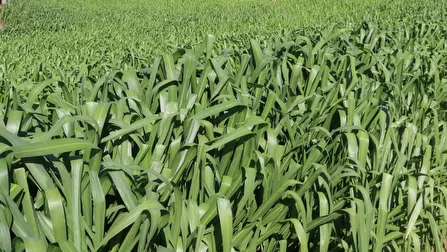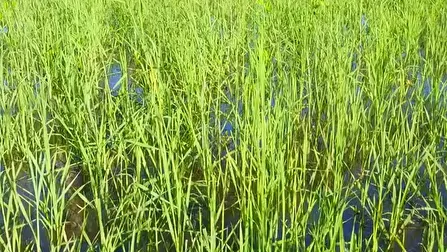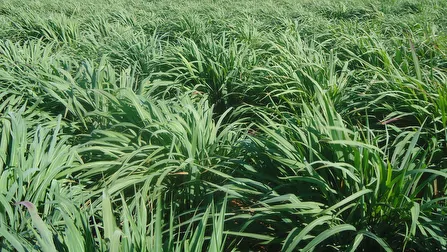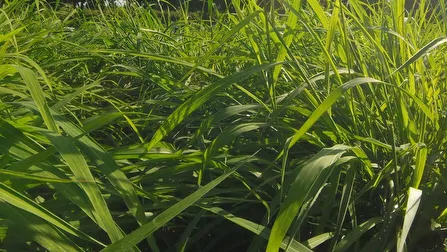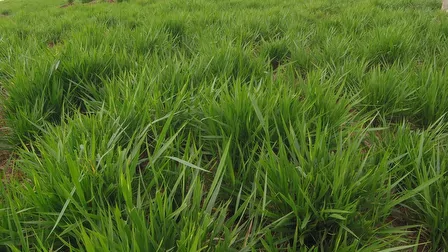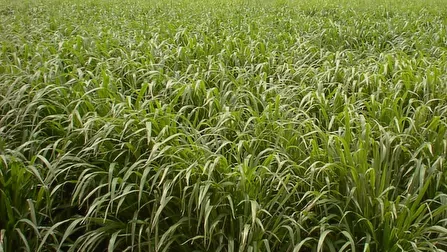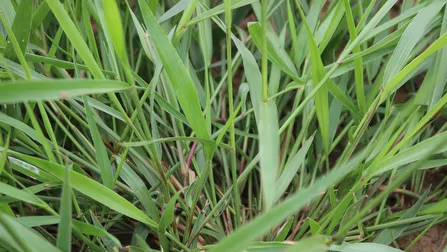
Indicação
Indicado para solos de média a baixa fertilidade, arenosos, com acidez e excesso de umidade. Recomendado para bovinos de cria e recria, também para equinos, caprinos e ovinos. Possui boa tolerância a cigarrinha das pastagens. Variedade rústica e persistente, com facilidade de propagação por ser estolonífera.
Urochloa humidicola cv. Llanero
Brachiaria humidícula cv. Llanero
Baixa fertilidade, tolera acidez, solos arenosos e com problema de drenagem (umidade temporária)
Pastejo direto ou fenação
8 a 10 t/ha/ano de matéria seca (M.S.)
4 a 7%
Até 1,0m
Boa
Boa
Boa
Tolerante
Média
Perene
Utilização e Manejo
A Dictyoneura é uma cultivar indicada para propriedades com solos com baixa fertilidade, problemas de acidez ou má-drenagem de umidade. Apesar de sua forragem de qualidade inferior (4-7% P.B.), pode ser utilizado para alimentação de animais exigente como equinos, complementadas por uma suplementação mineral adequada. É utilizada para bovinos principalmente na fase de cria e recria. Em pastagens associadas com Arachis pintoi, foram obtidos ganhos de peso vivo por animal por ano de 124 a 183 kg e ganhos por hectare variando de 267 a 540 kg de peso vivo. No desenvolvimento inicial deste pasto, assim como a humidícola, o primeiro pastejo deve ser efetuado de forma suave para estimular o perfilhamento e o enraizamento dos estolões. A dictyoneura sofre do mesmo problema que a humidícola e perde a qualidade nutricional mais rapidamente que outras braquiárias se amadurecerem. Recomenda-se utilizar altas cargas de animais ou maior frequência de pastejo, pois desta maneira os animais pastoreiam uma forragem mais tenra e de melhor qualidade nutricional e de melhor digestibilidade.
Origem
Esta cultivar foi lançada comercialmente na Colômbia pelo ICA (Instituto Colombiano Agropecuário) em 1987. As sementes (CPI 59610) vieram do Commonwealth Scientific and Industrial Research Organisation (CSIRO) da Austrália, que foi introduzido pelo CIAT em 1978 sob o no CIAT 6133. Conhecida como dictyoneura, foi coletada originalmente no Zimbabwe (exZâmbia) em 1971. Atualmente é comercializada em todo o Brasil e na América Latina.
Características Morfológicas
Gramínea de ciclo perene, semiereta a prostrada, estolonífera e rizomatosa, de 40 a 90 cm de altura, estolões compridos de cor púrpura com pilosidade de cor branca, folhas lanceoladas de 4 a 6 cm de comprimento e 0,8 cm de largura, raízes adventícias superficiais. As folhas são lineares lanceoladas, eretas, glabras, de cor púrpura, com uma das bordas denticuladas. Os talos e as nervuras das folhas são verdes com manchas púrpuras. A inflorescência é uma panícula com três ou quatro racemos de 18 4 a 6 cm de comprimento, cada um com 10 a 22 espiguetas alternas, sobre uma raque de cor púrpura verde em forma de zigue-zague.
Características Agronômicas
Possui as mesmas características que a humidícola, tolera solos de baixa fertilidade, ácidos, mas não tolera a mesma quantidade de água no solo. Também é hospedeira de cigarrinhas e não demonstra sintomas de seu ataque. As sementes também apresentam dormência, porém em menor intensidade, pois são colhidas do solo pelo método de varredura. As sementes deste cultivar apresentam dormência, chegando, inclusive, a até um ano depois de colhidas. Recomenda-se deixar a semente exposta, durante pelo menos um dia todo, espalhado a pleno sol sobre uma lona preta ou um terreiro, remexendo a cada hora com os pés, para que o aquecimento seja uniforme. Este aquecimento da semente, que pode alcançar até 50oC, auxilia na quebra da dormência. A dormência pode acarretar problemas durante o estabelecimento da pastagem, pois como a semente demora a germinar (mesmo em condições normais de temperatura, luminosidade e umidade), sementes de ervas daninhas e a vegetação nativa germinam primeiro e "dominam"" a área de plantio. Isto provoca o sombreamento do solo que não recebe mais luz e se torna frio, afetando ainda mais a germinação das sementes da dictyoneura. Se isto ocorrer deve proceder a roçada da área. A recomendação para evitar este problema, além do aquecimento das sementes de dictyoneura, é semeá-la associada, com 15% da dosagem normal, com ruziziensis ou outra braquiária. Outra opção é misturar com 5kg/ha (no máximo) de sementes de milheto. Este cultivar pode ser consorciado com Pueraria phaseoloides , Macrotyloma axillare (Java) e Arachis pintoi."
